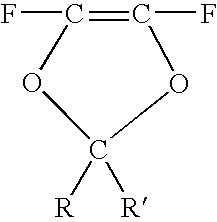Method for producing stabilized fluoropolymer
a technology of stabilized fluoropolymer and stabilized fluoropolymer, which is applied in the field of stabilized fluoropolymer production, can solve the problems of affecting the physical properties, the failure of molding or mold corrosion, and the inability to convert copolymer to the desired intermediate, so as to reduce the restrictions on the apparatus and materials to be used, reduce the contamination of fluoropolymer, and reduce the effect of corrosion
- Summary
- Abstract
- Description
- Claims
- Application Information
AI Technical Summary
Benefits of technology
Problems solved by technology
Method used
Image
Examples
example 1
1. Step A
[0172]A 300-ml stainless steel autoclave was charged with 50 g of pellets of a fluoropolymer (MFR: 12.5 (g / 10 minutes), melting point: 303° C.) consisting of 94.3% by mass of tetrafluoroethylene [TFE] units and 5.7% by mass of perfluoro(propyl vinyl ether) [PPVE] units. The autoclave was hermetically sealed and, after airtightness testing, the pressure was reduced to about 1.3 kPa using a vacuum pump and then returned to ordinary pressure with nitrogen gas; this procedure was repeated 10 times. The autoclave was then heated on an oil bath and, after confirmation of arrival of the inside temperature at 180° C., the autoclave was again evacuated, a gas prepared by diluting fluorine gas (purity 99.7% by mass) to 20% by mass (15.4% by volume) with nitrogen was introduced into the autoclave until arrival at a gage pressure of 0.01 MPa and the reaction was thus allowed to start. After 1.5 hours from the start of the reaction, evacuation was carried out and fluorine gas immediatel...
example 2
[0198]Fluoropolymer treatment was carried out in the same manner as in Example 1 except that, in step A, the reaction temperature was 160° C. and the reaction time was 6.5 hours and, in step C, the reaction temperature was 160° C. and the reaction time was 3 hours. On that occasion, the polymer obtained in step A was designated as Sample 6, the polymer obtained in the subsequent step B as Sample 7, and the polymer obtained in the further subsequent step C as Sample 8.
example 3
[0207]The procedure of Example 1 was followed in just the same manner except for the following points. The fluoropolymer to be treated used was a powder of a fluoropolymer made of 96.0% by mass of TFE and 4.0 by mass of PAVE (MFR: 25 (g / 10 minutes)).
[0208]In the step A, SF4 (purity 94% by mass) was used as the halogenating agent in lieu of the gas prepared by diluting fluorine gas with nitrogen and the reaction was carried out at a temperature of 120° C. for 4 hours to give Sample 11. In the step B, the size of the sample treated was 50 g and Sample 12 was obtained. In the step C, the reaction was carried out at 140° C. for 5 hours to give Sample 13. Further, the respective samples were subjected to the test mentioned above.
[0209]The results of analysis of the samples obtained are shown in Table 4.
[0210]It was revealed that the use of SF4 makes it possible to convert —CF2COOH to —CF2COF rapidly under mild conditions even if highly reactive fluorine gas is not used.
[0211]
TABLE 4Examp...
PUM
| Property | Measurement | Unit |
|---|---|---|
| temperature | aaaaa | aaaaa |
| temperature | aaaaa | aaaaa |
| temperature | aaaaa | aaaaa |
Abstract
Description
Claims
Application Information
 Login to View More
Login to View More - R&D
- Intellectual Property
- Life Sciences
- Materials
- Tech Scout
- Unparalleled Data Quality
- Higher Quality Content
- 60% Fewer Hallucinations
Browse by: Latest US Patents, China's latest patents, Technical Efficacy Thesaurus, Application Domain, Technology Topic, Popular Technical Reports.
© 2025 PatSnap. All rights reserved.Legal|Privacy policy|Modern Slavery Act Transparency Statement|Sitemap|About US| Contact US: help@patsnap.com

